Book contents
- Frontmatter
- Contents
- Introduction
- List of symbols and abbreviations
- 1 Species associations
- 2 Vegetation in West Africa
- 3 Annonaceae – soursop family
- 4 Amaranthaceae – amaranth family
- 5 Cucurbitaceae – gourd family
- 6 Ochnaceae – ironwood family
- 7 Combretaceae – afara family
- 8 Guttiferae (Clusiaceae) – butter tree family
- 9 Sterculiaceae – cocoa family
- 10 Bombacaceae – silk cotton family
- 11 Malvaceae – cotton family
- 12 Euphorbiaceae – cassava family
- 13 Caesalpiniaceae – pride of Barbados family
- 14 Mimosaceae – Acacia family
- 15 Papilionaceae – cowpea family
- 16 Ulmaceae – afefe family
- 17 Moraceae – mulberry family
- 18 Meliaceae – mahogany family
- 19 Sapindaceae – akee apple family
- 20 Anacardiaceae – cashew nut family
- 21 Sapotaceae – sheabutternut family
- 22 Apocynaceae – frangipani family
- 23 Asclepiadaceae – blood flower or milkweed family
- 24 Rubiaceae – abura family
- 25 Compositae (Asteraceae) – Tridax family
- 26 Solanaceae – tomato family
- 27 Convolvulaceae – sweet potato family
- 28 Bignoniaceae – jacaranda family
- 29 Acanthaceae – Thunbergia family
- 30 Verbenaceae – teak family
- 31 Labiatae (Lamiaceae) – Hausa potato family
- 32 Commelinaceae – day flower family
- 33 Zingiberaceae – ginger family
- 34 Marantaceae – (West Indian) arrowroot family
- 35 Liliaceae – lily family
- 36 Araceae – cocoyam family
- 37 Palmae (Arecaceae) – palm family
- 38 Orchidaceae – orchid family
- 39 Cyperaceae – sedge family
- 40 Gramineae (Poaceae) – grass family
- General bibliography
- Index of family, generic and common names
39 - Cyperaceae – sedge family
Published online by Cambridge University Press: 02 November 2009
- Frontmatter
- Contents
- Introduction
- List of symbols and abbreviations
- 1 Species associations
- 2 Vegetation in West Africa
- 3 Annonaceae – soursop family
- 4 Amaranthaceae – amaranth family
- 5 Cucurbitaceae – gourd family
- 6 Ochnaceae – ironwood family
- 7 Combretaceae – afara family
- 8 Guttiferae (Clusiaceae) – butter tree family
- 9 Sterculiaceae – cocoa family
- 10 Bombacaceae – silk cotton family
- 11 Malvaceae – cotton family
- 12 Euphorbiaceae – cassava family
- 13 Caesalpiniaceae – pride of Barbados family
- 14 Mimosaceae – Acacia family
- 15 Papilionaceae – cowpea family
- 16 Ulmaceae – afefe family
- 17 Moraceae – mulberry family
- 18 Meliaceae – mahogany family
- 19 Sapindaceae – akee apple family
- 20 Anacardiaceae – cashew nut family
- 21 Sapotaceae – sheabutternut family
- 22 Apocynaceae – frangipani family
- 23 Asclepiadaceae – blood flower or milkweed family
- 24 Rubiaceae – abura family
- 25 Compositae (Asteraceae) – Tridax family
- 26 Solanaceae – tomato family
- 27 Convolvulaceae – sweet potato family
- 28 Bignoniaceae – jacaranda family
- 29 Acanthaceae – Thunbergia family
- 30 Verbenaceae – teak family
- 31 Labiatae (Lamiaceae) – Hausa potato family
- 32 Commelinaceae – day flower family
- 33 Zingiberaceae – ginger family
- 34 Marantaceae – (West Indian) arrowroot family
- 35 Liliaceae – lily family
- 36 Araceae – cocoyam family
- 37 Palmae (Arecaceae) – palm family
- 38 Orchidaceae – orchid family
- 39 Cyperaceae – sedge family
- 40 Gramineae (Poaceae) – grass family
- General bibliography
- Index of family, generic and common names
Summary
Superficially grass-like herbs, in ecological descriptions grouped with grasses as graminoids. The family is a mainly temperate one, occurring also in arctic areas. Most sedges are helophytes or mesophytes growing in seasonally wet places. There are a few hydrophytes in West Africa (Websteria confervoides and a few species of Eleocharis and Scirpus). West African species are mainly perennials, the widespread ones also tending to occur in most of the rest of tropical Africa at least. Less than half West African genera extend to Gambia. Habitat lists of species are to be found in Chapter 2.
Some of the terminology developed for describing grasses is also applied to sedges. The leafy erect aerial shoots (culms) are rosette shoots, the leaves mostly basal and separated from each other by only very short internodes. In perennial species, the culms arise from slender sympodial rhizomes, each culm terminating an increment of growth. The internodes of the rhizome may be long, resulting in a spreading habit, or very short, when a tufted habit similar to that of annual species results. Stem tubers are developed in at least two forms. Terminal tubers on stolons (Solanum tuberosum fashion) occur in nut grass (Cyperus rotundus), one of West Africa's most pernicious weeds, and the edible tiger nut (C. esculentus). Each tuber then produces a culm and several more stolons (but see Lorougnon, 1970).
- Type
- Chapter
- Information
- Flowering Plants in West Africa , pp. 312 - 320Publisher: Cambridge University PressPrint publication year: 1988



